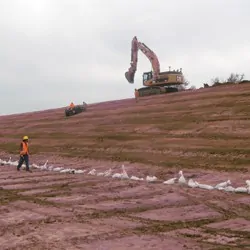


Our industry experience speaks for itself. The SCS team includes hydrologists, geologists, groundwater professionals, licensed professional engineers, construction experts, and regulatory professionals who provide clear advice founded on years of experience helping clients site, design, construct, operate and close modern landfills.
We understand that safe and reliable CCR disposal is critical for continued operations – even for utilities that beneficially use CCR, as beneficial use is often subject to market forces that affect demand. Evaluating options – finding the right location and design concept for a new landfill, expanding an existing landfill, contracting for third-party disposal at the landfill, etc. – is not always straightforward. Finding the right option at an active plant or at a plant that is slated for decommissioning can be especially challenging.
New CCR landfills and lateral expansions of existing landfills must meet specific location criteria as well as specific liner and leachate collection requirements. If they are to be constructed atop a former CCR impoundment area, specific closure requirements must be met for the impoundment in addition to addressing the geotechnical challenges of supporting the new landfill atop the impoundment.
The by-products of coal combustion residuals can be difficult to manage in a landfill, particularly if the materials are mixed with other wastes. Some CCR materials are high in sulfides and under certain circumstances can produce hydrogen sulfide gas in amounts sufficient to cause a safety or odor problem. Dust control can be a challenge, and some CCR materials can clog leachate collection and other environmental systems.
SCS Engineers helps landfill operators develop and implement appropriate procedures for dust control, stormwater management, and maintenance of environmental controls at landfills and impoundments. Automated collection of inspection and other operating data can be managed with data collection systems that facilitate compliance, including compliance with public information requirements such as posting operating data to a public website.
We capitalized on our experience at hundreds of landfills to develop SCS eTools®, a data management system that helps clients collect and manage data in order to comply with complex regulations.
Existing CCR impoundments must meet specific location criteria, and existing liner systems must meet an impermeability standard. If an existing impoundment liner does not meet the standard, it must be retrofitted with an appropriate liner, or it will be subject to closure if there is a significant release to groundwater. Impoundments also must be designed to withstand certain flood events, and they are subject to periodic hazard assessments. Impoundments that present a significant hazard must prepare a written emergency action plan. In addition, big and tall impoundments must prepare periodic structural integrity evaluations and publish the results to a public website.
SCS Engineers’ professionals understand dams and dam safety, and we understand coal ash impoundments. Working with our construction colleagues, we help utilities evaluate options to repair and improve existing impoundments in order to protect public safety and comply with regulations.

When it is time to close an impoundment, we design a final cap that addresses geotechnical limitations as well as potential post-closure land uses. We have helped utilities redevelop some closed impoundments and other disposal areas for productive land uses such as alternative energy production.